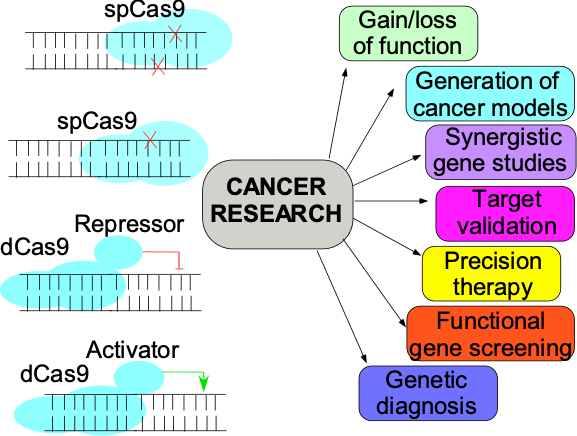
Over the last few decades, RNAi and ORF transfection were the most popular tools for the loss- or gain-of-function studies at the mRNA level. Zinc finger nuclease (ZFN) and transcription activator like endonuclease (TALEN) were two of the first technologies developed for targeted editing of the genome. Challenges with these technologies included low efficiency and the need for complex experimental procedure. CRISPR is an emerging versatile technology that provides many options for cancer research. The CRISPR/Cas9 system provides the ability to add or remove DNA in the genome in a sequence-specific manner. The technology utilizes the non-homologous end joining (NHEJ) or the homology directed repair (HDR) DNA repair systems to knock out gene expression or tocorrect a specific genome sequence, respectively. If introducing a single mutation in the HNH or RuvC domain of the Cas9 protein, the system will work as a nickase to create a single strand break instead of a double strand break, which has led to several innovative applications. Additional CRISPR systems have been developed, like CRISPR activation (CRISPRa) or CRISPR interference (CRISPRi), which have dramatically increased and diversified the applications of CRISPR. In these systems, a functional transcriptional activator or repressor is conjugated to a deactivated Cas9 (dCas9) protein and the system can be used to increase or inhibit the target gene transcription.
Cancer is a highly complex process entailing multiple gene, protein, and signaling pathway interactions. Scientists and researchers have been attempting todecipher the mechanisms of cancer occurrence, development, invasion, and metastasis, and CRISPR has clearly accelerated the research efforts. Presently, CRISPR technology is being used to investigate the genetic mechanisms in almost all areas of cancer from prevention to prognosis and treatment, which greatly promotes transition of research findings to the clinic. With the CRISPR system, genetically engineered cancer modelsnow can be produced rapidly, efficiently, and inexpensively. The CRISPR/Cas9 system also provides an effective strategy for the identification of synergistic gene interactions, which could be used to block drug resistance. The CRISPR system has also been widely used for functional genome-screening, which could reveal gene expression changes after treatment and pinpoint genes associated with drug resistance.This could assist inidentifying new biomarkers for precision therapy and provide new insights into the mechanisms of cancer development. Compared with older methods, the CRISPR-Cas-based genetic screening system(CRISPRres) is a powerful and efficient method for identifing new drug targets together with deep-sequencing or cellular biophysical assays. Another modified CRISPR system could even be used as a sensitive method for identification of genes that have a low frequency mutation.
Based on promising results of pre-clinical studies, the CRISPR/Cas9 system could also potentially be used clinically to target cancer-causing genes. Indeed, promising results have been achieved in diverse disciplines. The CRISPR system in cancer research has revolutionized the biological sciences and provided cancer biologists with a powerful gene-editing method that dramatically alter the ways in which cancer is treated.





Please sign in or register for FREE
If you are a registered user on Research Communities by Springer Nature, please sign in